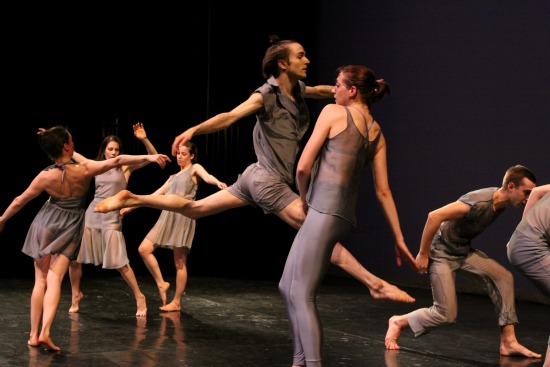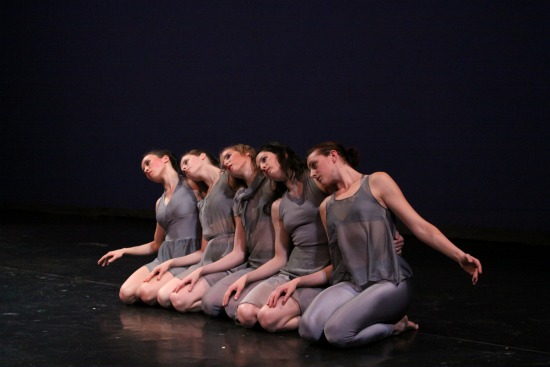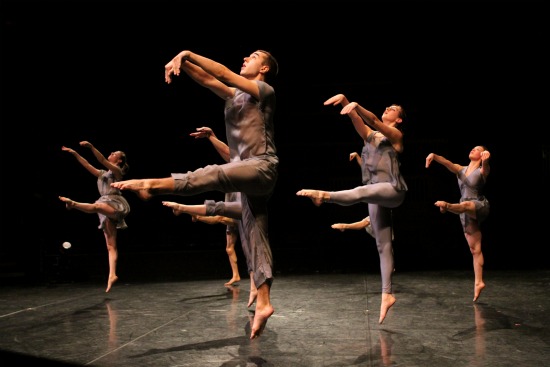
Pat Catterson's To Lie in the Sky, Jesse Dunham (foreground) ,Timothy Emmett Ward (leaping). Photo: Steven Schreiber
At the very end of Pat Catterson’s gentle, beautifully crafted new dance, To Lie in the Sky, a voice recites the plangent opening lines of May Swenson’s “The Question”— “Body my house/ my horse my hound/ what will I do when you are fallen.” Catterson took her title from that poem’s penultimate query: “How will it be/ to lie in the sky/ without roof or door/ and wind for an eye.”
These are not thoughts a young person might be drawn to. Catterson—whose piece was shown at La Guardia High School’s Little Flower Theater, February 17th and 18th—has been choreographing and dancing and teaching since the late 1960s. She’s garnered grants, awards, and fellowships (a Guggenheim in 2011). The child of vaudevillians, she has created innovative tap pieces along with her barefoot forays into postmodernism. Since 1999, she’s been performing with Yvonne Rainer’s resurrected, reconstructed company and serving as a rehearsal assistant.
To Lie in the Sky unrolls both like a road linking the countries that Catterson has traveled in and the road through a life. Nadia Lesy’s intermittent projections include countryside and street scenes contributed by videographers in nine different countries, and Quentin Chiappetta’s subtle sound design heightens our awareness of places—their serenity, their bustle, their sirens, their sweet music. Philip W. Sandstrom’s lighting skillfully alters the space. A trenchcoat hangs high overhead (one of the many recorded voices we hear reading from a variety of writings mentions that a traveler must be prepared for anything).
The medium-sized Little Flower has steeply raked, almost semi-circular banks of seats, and while the audience is settling, several dancers are posing and stretching in the aisles, as if calculating distances (one of them gives me a picture of daffodils in a vase on someone’s floor). The first projection on the back wall is of low waves rolling up a beach. The first dancer to enter the stage, Alexandra Berger bends slowly down to feel the ground, then looks at her hands. Jesse Dunham strokes her own arms carefully. Another woman (I forget which) bolts down an aisle to join them, and Timothy Emmett Lee Ward propels himself down another aisle, on his back and headfirst. They all wear variously cut gray clothes by Juanita Cadenas.

Suzanne Thomas, Becky Chaleff, Liesbeth Demaer Ingenito, Alexandra Berger, Jesse Dunham. Photo: Steven Schreiber
From this understated beginning, the dancing swells—never becoming violent, varying in dynamics and patterns without the performers ever losing their air of exploration, of sensing the environment. When Suzanne Thomas, just once, slowly unfolds one leg into what would be a developpé in ballet, it looks like a probe. At times, the seven performers appear to be on private errands, spaced out around the stage—some of them perhaps still and gazing outward. In one passage, a person settles into a pose, and another comes up and carefully, almost tenderly, fits into that pose—altering and augmenting it; after a moment the first person may leave to form another temporary alliance. Every now and then, as they walk or run, they toss off a dance step or two—a leap, a spin, the high swing of a leg.
Some of the words spoken in To Lie in the Sky tell of research into the brain and the mysterious interconnections between its right and left hemispheres. If you like, you can let the words drift down onto dance patterns that bespeak synapses and the flow of sensations. Five of the seven dancers stand pressed together in a chain. Ward and Samuel Swanton dance in a canon that slips into unison. Berger, Dunham, Thomas, Becky Chaleff, and Liesbeth Demaer Ingenito, line up and sit on their heels like geishas, each one’s head inclined to rest on the shoulder of the colleague on her right. All of them periodically assemble in clumps, with a single explorer or a pair emerging from it to make a brief, private voyage.
They share certain repeated gestures—lifting both arms high or spreading them as if to open themselves to the sky, or, in a more obviously significant movement, hugging themselves and shivering in a suddenly frigid climate. When this happens, we hear the sound of feet running, and coats fall from the sky. The dancers put them on and leave.
It’s not over yet. Another figure appears, curling up in a front-row seat, then walking along the low wall that separates spectators from the stage. Whether Maia Ramnath represents a transfigured soul or, like the choreographer, a seeker of truth, she’s extraordinary. Ramnast is an experienced aerial dancer, as well as an on-the-ground one; with her short hair, lean body, and high-definition muscles, she could be one of those grave, androgynous angels of Renaissance painting. And she dances gorgeously—fluently, amply, without strain. Running in swift circles, turning, jumping, she’s making the climactic voyage to the stars.
Swenson’s poem asks its final question: “With cloud for shift/ how will I hide?” Perhaps Catterson’s unspoken answer is “You won’t.”


I attended this performance, which was amazing and thought-provoking. The choreography, dancers, costumes, lighting and composition were wonderful
Pat—
What a fantastic review. I wish I had been there to see it for myself. Finally DJ gets it. I wish I could send roaring applause with this note. xoxoxo Lewis